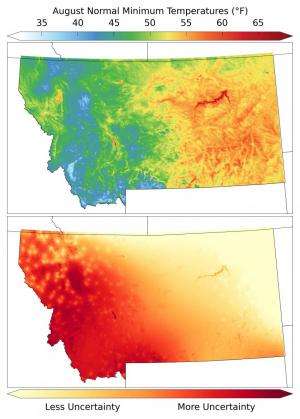Study improves temperature modeling across mountainous landscapes

New research by University of Montana doctoral student Jared Oyler provides improved computer models for estimating temperature across mountainous landscapes.
The work was published Aug. 12 in the International Journal of Climatology in an article titled "Creating a topoclimatic daily air temperature dataset for the conterminous United States using homogenized station data and remotely sensed land skin temperature."
Collaborating with UM faculty co-authors Ashley Ballantyne, Kelsey Jencso, Michael Sweet and Steve Running, Oyler provided a new climate dataset for ecological and hydrological research and natural resource management.
"I think we have addressed several limitations of existing temperature datasets," Oyler said.
He used data from weather stations, as well as atmospheric weather model data and satellite-based observations, to come up with daily temperature estimates from 1948 to 2012 for every square kilometer in the contiguous United States.
Many existing datasets generally assume that temperatures are cooler at higher elevations. However, inversions often cause the reverse. For example, on a calm winter day or summer night in Missoula, the air may be warmer on Mount Sentinel than in the valley. Oyler's dataset addresses the oddities of inversions by combining weather station data with fine scale satellite-based observations of the land surface.
Accurate, spatially based estimates of historical air temperature within mountainous areas are critical as scientists and land managers look at temperature-driven changes to vegetation, wildlife habitat, wildfire and snowpack.
Additionally, the dataset is the first fine-scale work to correct for artificial trends within weather station data caused by changes in equipment or weather station locations. It also is the first to provide direct estimates of uncertainty and to provide open-source code.
"As an open-source dataset, researchers can easily access and use the data and understand its strengths and limitations and improve it themselves," Oyler said.
Provided by University of Montana




















